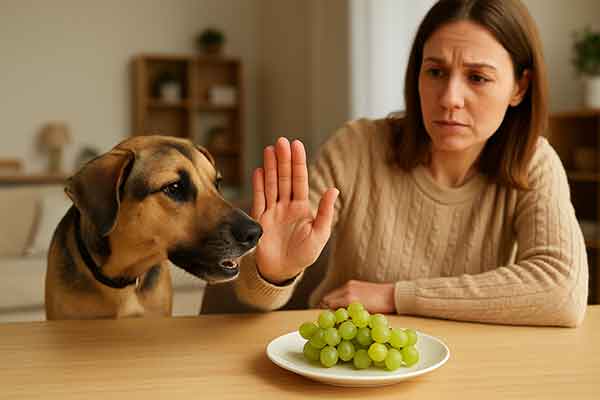What Can’t Dogs Eat? A Comprehensive Guide to Toxic Foods for Dogs
Dogs are curious eaters, and many pet owners love to share a bite from their plate. But some human foods are not only unhealthy for dogs—they’re downright dangerous. If you’ve ever wondered, “What can’t dogs eat?”, this guide will walk you through the most common foods that are harmful to dogs, the symptoms of poisoning, and how to protect your furry friend from accidental ingestion.
Table of Contents
- Why Some Human Foods Are Toxic to Dogs
- Top Toxic Foods Dogs Should Never Eat
- Foods That Aren’t Toxic but Should Be Limited
- Symptoms of Food Poisoning in Dogs
- What to Do If Your Dog Eats Something Harmful
- Healthy Alternatives to Dangerous Foods
- Frequently Asked Questions
Why Some Human Foods Are Toxic to Dogs
Dogs process food differently than humans. Their digestive systems can’t handle certain chemicals and ingredients that are harmless to us. Factors like a dog’s size, breed, age, and existing health conditions can all impact how they react to a particular food. Even small amounts of toxic substances can cause severe reactions or long-term damage.
Top Toxic Foods Dogs Should Never Eat
Below are some of the most dangerous foods for dogs. These should be completely avoided to prevent poisoning, illness, or even death.
1. Chocolate
Chocolate contains theobromine and caffeine—both highly toxic to dogs. Dark chocolate and baking chocolate are the most dangerous.
2. Grapes and Raisins
Even small quantities can cause sudden kidney failure in dogs. The exact toxin is unknown, but the effects are well documented.
3. Onions and Garlic
Both contain compounds that destroy red blood cells and can lead to anemia. All forms—raw, cooked, powdered—are dangerous.
4. Xylitol
This sugar substitute, often found in gum, candy, and baked goods, can cause insulin release, leading to liver failure and hypoglycemia.
5. Alcohol
Even tiny amounts of alcohol can be fatal to dogs. It affects the central nervous system and can cause vomiting, tremors, and coma.
6. Macadamia Nuts
Can cause vomiting, weakness, depression, and tremors. The toxin is still unknown, but the effects are serious.
7. Avocados
Contain persin, which can cause vomiting and diarrhea in dogs. The pit is also a choking hazard.
8. Cooked Bones
They can splinter easily and cause choking, internal bleeding, or intestinal blockages.
9. Caffeine
Found in coffee, tea, energy drinks, and some medications. Like chocolate, it stimulates the nervous system and can be fatal.
10. Raw Dough
Uncooked yeast dough can expand in your dog’s stomach, causing bloating and potentially life-threatening complications.

Foods That Aren’t Toxic but Should Be Limited
Some human foods aren’t toxic to dogs but can still lead to obesity, digestive issues, or nutritional imbalances if overfed.
- Dairy Products: Many dogs are lactose intolerant and may experience bloating or diarrhea.
- Fatty Meats: Bacon and other high-fat meats can cause pancreatitis.
- Salt: Excessive salt can lead to sodium ion poisoning and dehydration.
- Sugar: Leads to weight gain, dental issues, and diabetes.
- Raw Meat and Eggs: Risk of bacterial infections like Salmonella or E. coli.
Symptoms of Food Poisoning in Dogs
Signs of toxic ingestion vary based on the food and the amount consumed. Common symptoms include:
- Vomiting and diarrhea
- Lethargy or weakness
- Loss of coordination
- Seizures or tremors
- Excessive drooling or panting
- Abdominal pain
- Unusual behavior or agitation
Symptoms can appear within minutes or take several hours. Always monitor your dog closely if you suspect they’ve eaten something harmful.
What to Do If Your Dog Eats Something Harmful
If you suspect your dog has ingested a toxic food:
- Identify what and how much was eaten
- Call your veterinarian or an emergency pet poison hotline immediately
- Do not induce vomiting unless instructed by a vet
- Monitor your dog’s symptoms and behavior closely
Quick action can save your dog’s life. Don’t wait for symptoms to worsen.
Healthy Alternatives to Dangerous Foods
Instead of sharing potentially harmful foods, try these dog-safe alternatives:
- Carrots: Low-calorie and great for dental health
- Blueberries: Packed with antioxidants
- Apple slices (no seeds): Provide vitamins and fiber
- Cooked sweet potatoes: Easy to digest and nutritious
- Plain rice or oatmeal: Gentle on the stomach
Always introduce new foods slowly and in moderation.
Frequently Asked Questions
Can one grape really harm a dog?
Yes, even one grape or raisin can cause kidney failure in some dogs. Sensitivity varies, but it’s best to avoid them entirely.
Is peanut butter safe for dogs?
Yes, if it’s xylitol-free and given in moderation. Always read the ingredient label.
Can dogs eat eggs?
Cooked eggs are a healthy source of protein. Avoid raw eggs due to the risk of salmonella.
Why is chocolate bad for dogs?
Chocolate contains theobromine, which is toxic to dogs and can affect the heart and nervous system.
What should I do if my dog eats garlic or onions?
Contact your vet immediately. Garlic and onions can destroy red blood cells and lead to anemia.
Conclusion
Understanding what can’t dogs eat is a vital part of responsible pet ownership. While it might seem harmless to share a bite of your meal, many common foods are dangerous—or even deadly—to dogs. Keep this guide in mind, educate your household, and always consult your vet when in doubt. A safe diet is the foundation of a long, healthy life for your furry companion.
